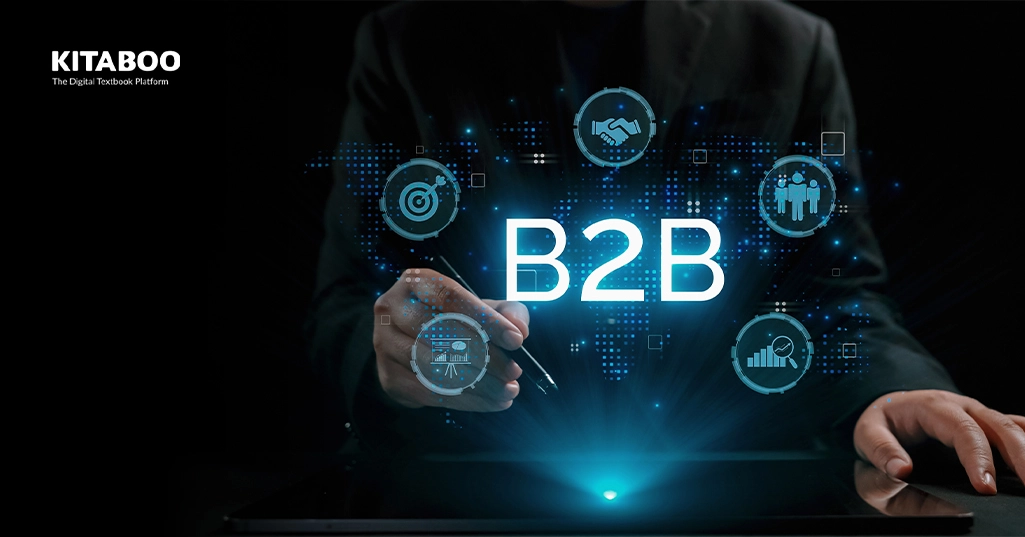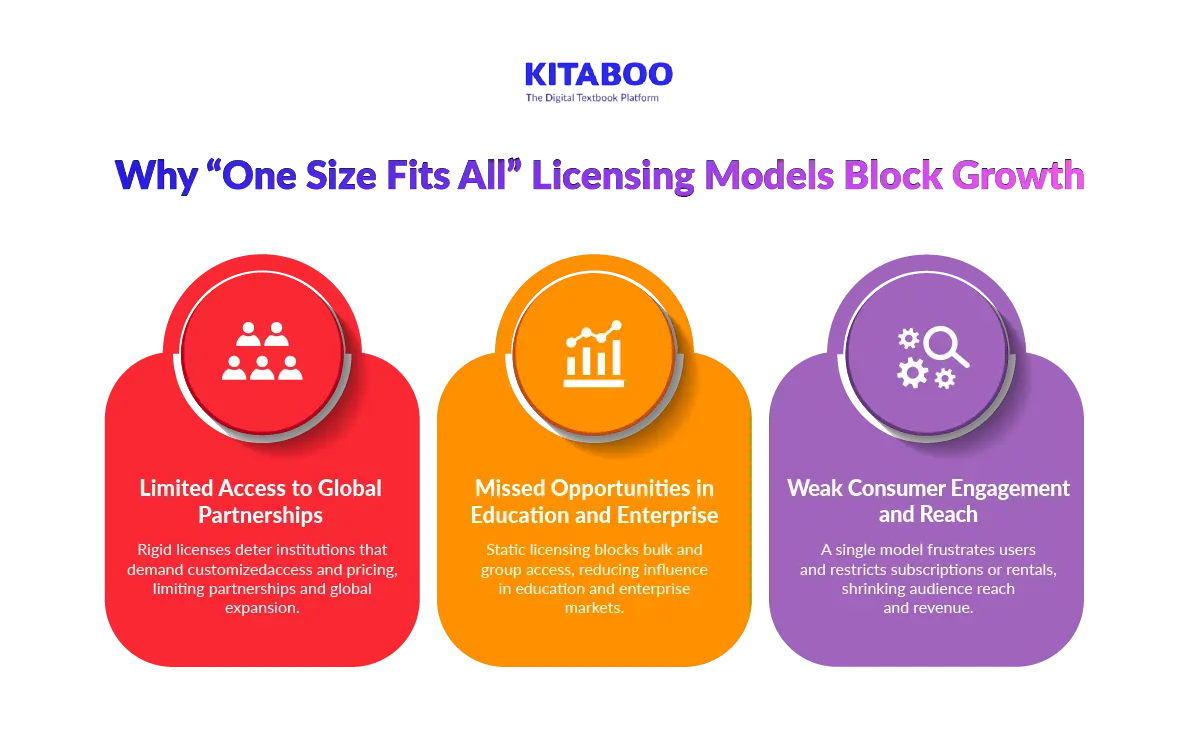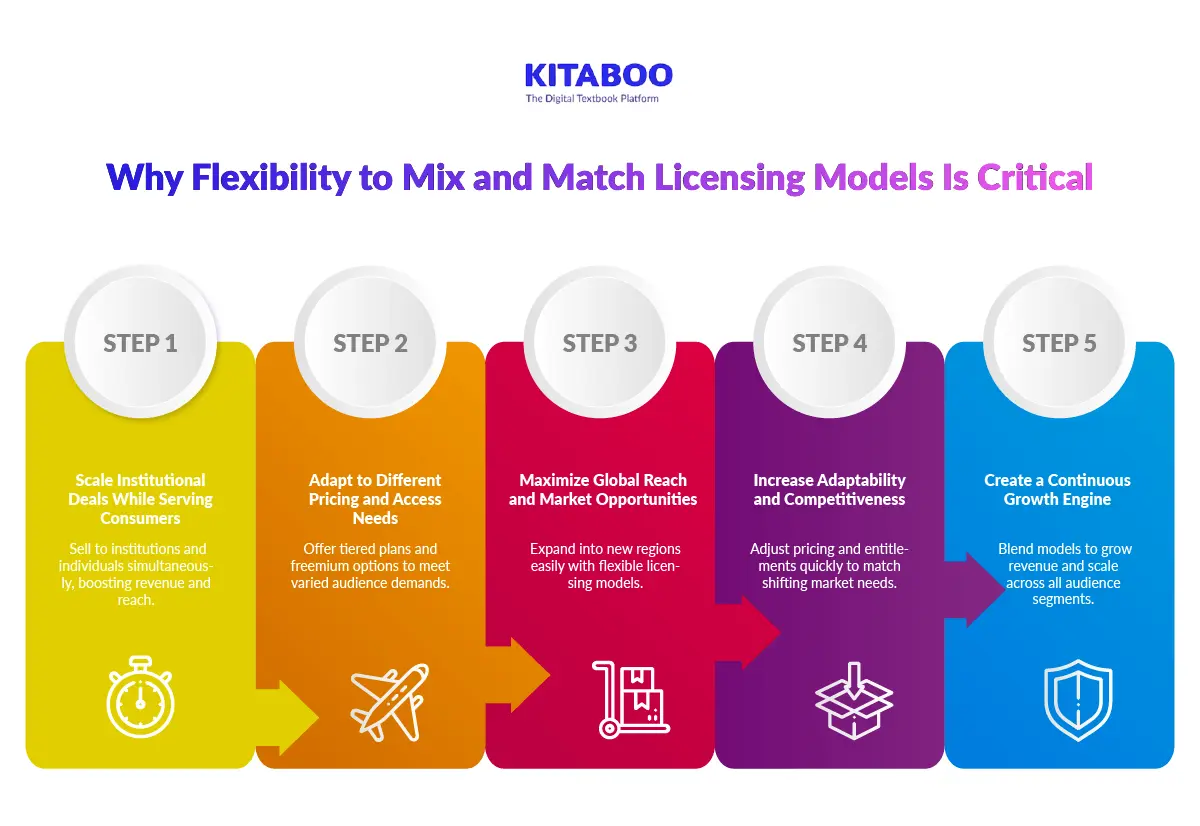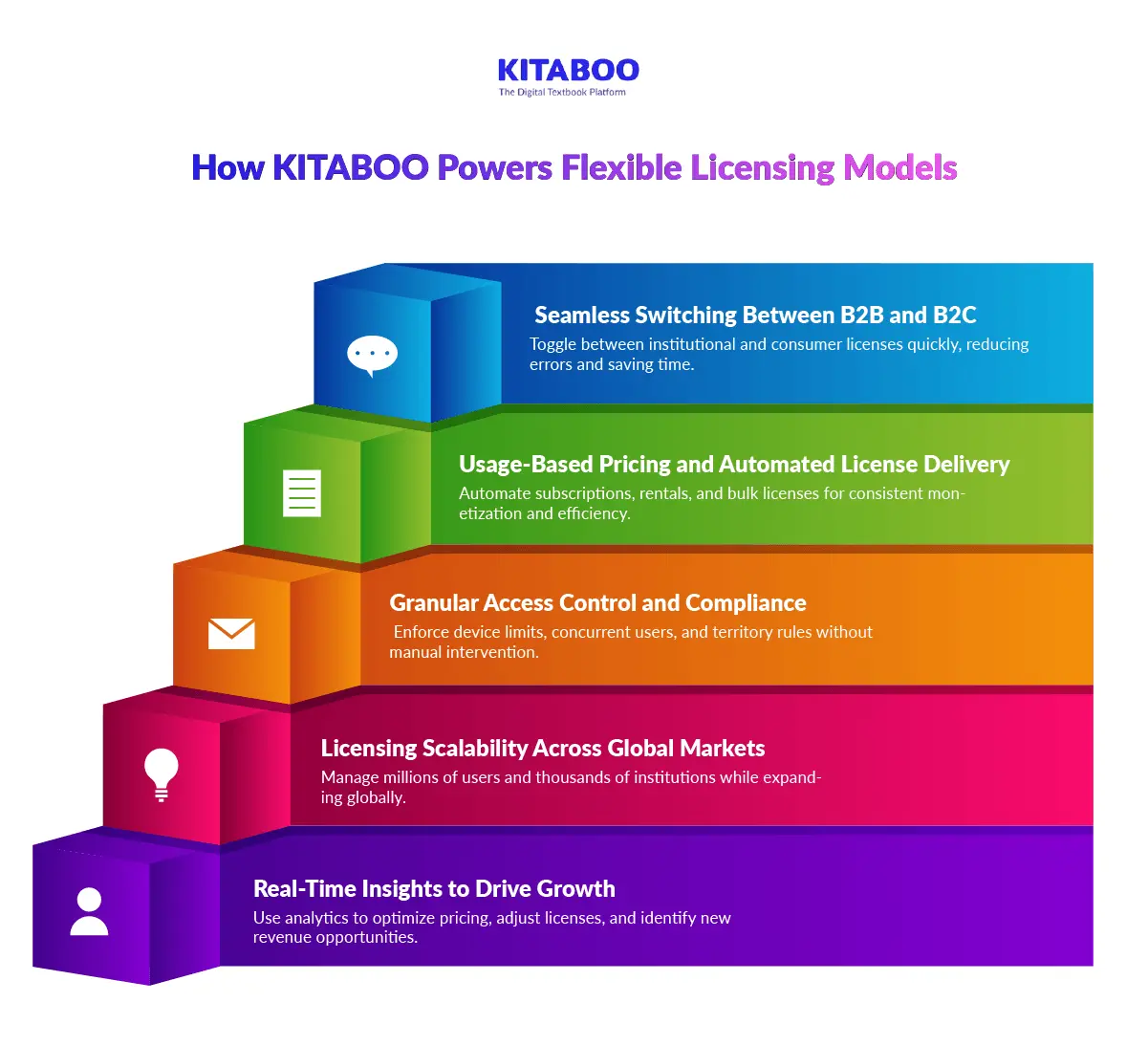
Why Flexible B2B and B2C Licensing Models Unlock Maximum Digital Reach
Summarize this blog with your favorite AI:
Why Flexible B2B and B2C Licensing Models Unlock Maximum Digital Reach – TL;DR
The success of modern aggregators depends on mastering licensing models. A single, rigid model limits opportunities and slows global reach. Digital license flexibility helps aggregators tailor access, pricing, and delivery for every audience and market.
With strong licensing scalability, aggregators can combine models, automate access, and grow across regions. The right mix creates balance, expands revenue, and keeps both institutions and consumers satisfied.
B2B vs B2C Licensing Comparison
| Aspect | B2B Licensing | B2C Licensing |
|---|---|---|
| Target Audience | Serves institutions, schools, and enterprises seeking structured content access. | Reaches individual readers, learners, and professionals directly. |
| Access Model | Uses bulk seat, concurrent, or institutional subscription models. | Offers subscription, rental, or pay-per-use options. |
| Revenue Pattern | Ensures predictable income through long-term contracts and renewals. | Delivers recurring or microtransaction-based income from individuals. |
| Scalability Focus | Supports institutional partnerships and academic expansion. | Drives global consumer adoption and engagement growth. |
| Strategic Value | Builds strong partnerships and global credibility. | Strengthens brand loyalty and direct market presence. |
It starts with a simple goal. Reach more readers. Build more partnerships. Grow faster. But soon, content aggregators discover that growth isn’t blocked by demand. It’s blocked by rigid licensing structures.
For many content aggregators, a single licensing model can’t meet the needs of every partner or audience. Licensing models built for scale often become roadblocks instead of growth engines.
Success today depends on B2B and B2C licensing models that adapt quickly. Content Aggregators need digital license flexibility to serve institutions and individuals at once. Without it, every new audience feels out of reach, and every partnership feels harder to win.
Table of Contents
- Why “One Size Fits All” Licensing Models Block Growth
- Why Aggregator Access Strategies Need Both B2B and B2C Licensing Models
- Why Flexibility to Mix and Match Licensing Models Is Critical
- Challenges Aggregators Face in Managing B2B and B2C Licensing Models
- How KITABOO Powers Flexible B2B and B2C Licensing Models
- Conclusion
- FAQs
Why “One Size Fits All” Licensing Models Block Growth
A single licensing approach cannot meet the needs of both institutions and consumers. B2B and B2C licensing models must adapt to changing audiences, pricing structures, and delivery expectations. Without that flexibility, expansion into new markets slows, and valuable opportunities vanish.
1. Limited Access to Global Partnerships
When licensing lacks adaptability, institutions hesitate to commit. Schools, universities, and corporations need tailored access levels and pricing. A rigid license structure pushes them away, blocking long-term deals.
Content Aggregators lose large-scale partnerships that could multiply revenue and global reach. Flexible aggregator access strategies are the foundation of licensing scalability and international growth.
2. Missed Opportunities in Education and Enterprise
Educational and corporate buyers require bulk seats or concurrent user access. Static licensing cannot support varied group sizes or shared accounts.
As a result, institutions look for platforms that offer digital license flexibility. Every missed integration or contract means lost influence in the education and enterprise markets.
3. Weak Consumer Engagement and Reach
Consumers expect personalized access, clear pricing, and simple renewals. A one-size model limits these experiences and frustrates users.
Without adaptable licensing models, aggregators can’t offer subscriptions, rentals, or freemium options that users love. Poor flexibility narrows audience reach, shrinking revenue and visibility.
Why Aggregator Access Strategies Need Both B2B and B2C Licensing Models
Aggregators who rely on a single licensing approach often trap their own growth. Aggregator access strategies must evolve as the market has changed. Success now depends on mastering both licensing models.
1. B2B Licensing Builds High-Value, Long-Term Partnerships
B2B licensing models create stability and scale through large institutional contracts. Bulk seat licensing gives schools, universities, and enterprises affordable group access. Concurrent or school-wide subscriptions simplify management and boost renewals.
Library lending models reach thousands of users across educational networks. These partnerships lock in predictable revenue and expand global credibility. With flexible aggregator access strategies, B2B deals become a steady foundation for growth.
2. B2C Licensing Drives Global Reach and Direct Engagement
B2C licensing models fuel visibility and direct consumer relationships. Subscriptions, rentals, and pay-per-use options attract individual readers, learners, and professionals worldwide.
These models bring faster feedback loops and recurring income. They also empower aggregators to test pricing, launch region-specific offers, and personalize user experiences. Strong B2B and B2C licensing models ensure no opportunity or audience is out of reach.
3. Combining Both Multiplies Reach, Revenue, and Scalability
True growth happens when B2B stability meets B2C scale. Aggregators that blend both models achieve licensing scalability and can serve institutions and individual consumers.
Each side strengthens the other. Institutional visibility drives consumer trust, and consumer demand attracts enterprise deals. With digital license flexibility, this synergy becomes easy to manage and endlessly scalable. The result is unstoppable growth across every market segment.
Why Flexibility to Mix and Match Licensing Models Is Critical
Aggregators often face conflicting demands from institutions and individual users. Rigid licensing limits their ability to respond. Flexibility in licensing scalability allows them to serve multiple audiences without compromise.
1. Scale Institutional Deals While Serving Consumers
Flexible licensing allows selling large content blocks to schools, universities, and enterprises. At the same time, individual users can access content through rentals or subscriptions.
Aggregators maintain control over entitlements and expiries across both groups. This approach increases revenue streams and strengthens long-term partnerships.
2. Adapt to Different Pricing and Access Needs
Institutions require predictable pricing and shared access, while consumers expect choice and convenience. Flexible digital license flexibility enables aggregators to offer tiered plans, temporary access, or freemium models.
Adjusting access rules for each audience ensures satisfaction and reduces revenue leakage. This approach turns licensing into a powerful engine for growth and licensing scalability.
3. Maximize Global Reach and Market Opportunities
Mixing and matching licensing models helps aggregators enter new regions and sectors. They can meet local compliance, pricing, and content preferences easily.
Flexible licensing models ensure every market segment, from schools to individual consumers, can be served efficiently. This drives growth and enhances global visibility.
4. Increase Adaptability and Competitiveness
Flexible pricing and entitlement models allow aggregators to respond quickly to market demands. They can launch new packages, adjust subscription lengths, or offer temporary promotions.
This adaptability increases competitiveness and helps capture emerging opportunities faster than rigid systems.
5. Create a Continuous Growth Engine
The mix-and-match flexibility lets aggregators serve institutions and individual users with equal efficiency. Selling large content blocks while offering rentals or subscriptions to individuals multiplies revenue streams.
Flexible B2B and B2C licensing models become the core growth engine. They enable aggregators to reach every audience type without operational strain.
Challenges Aggregators Face in Managing B2B and B2C Licensing Models
Even with flexible licensing models, managing aggregator access strategies can be difficult. Aggregators face technical and operational hurdles that slow growth. Balancing user convenience with content protection is critical but often complicated.
1. Device Limits and Concurrent User Restrictions
Many licenses restrict the number of devices or simultaneous users. Aggregators must track and enforce these limits carefully. Failure leads to frustrated users and potential revenue loss. Having digital license flexibility helps you manage device and concurrency rules efficiently.
2. Authentication for Group and Institutional Users
Institutional accounts require complex authentication for multiple users. Aggregators must verify credentials and manage access levels accurately. Errors can block legitimate users or allow unauthorized access. Strong authentication ensures both security and a smooth user experience.
3. Territory-Based Content Access and Compliance
Content licensing often involves region-specific restrictions. Aggregators must enforce territory rules and comply with local laws. Incorrect enforcement can lead to legal risks or blocked access. Properly configured B2B and B2C licensing models make global distribution manageable.
4. Maintaining Balance Between Security and Convenience
Every added security layer can reduce ease of use. Aggregators must protect content without frustrating users. Overly strict controls can lead to abandoned subscriptions or lost sales. Digital license flexibility helps maintain this balance while achieving licensing scaling efficiently.
How KITABOO Powers Flexible B2B and B2C Licensing Models
KITABOO empowers aggregators to manage all licensing models from a single platform. The digital license flexibility ensures every license converts into revenue and every user receives the right access.
1. Seamless Switching Between B2B and B2C
KITABOO allows aggregators to toggle effortlessly between institutional and consumer licenses. Bulk access, subscriptions, rentals, and pay-per-use coexist without conflict.
Institutions and individual users are managed on the same system, reducing errors and saving operational time. This agility lets aggregators expand into multiple market segments quickly.
2. Usage-Based Pricing and Automated License Delivery
Aggregators can implement usage-based pricing and automate license delivery with KITABOO. Subscriptions, rentals, bulk packages, and freemium models are handled automatically.
Renewals, expiries, and entitlement updates occur in real time. This reduces revenue leakage, increases operational efficiency, and ensures consistent monetization across all license types.
3. Granular Access Control and Compliance
KITABOO provides fine-grained control over users, groups, and institutions. Device limits, concurrent user restrictions, territory rules, and authentication can be enforced without manual intervention.
Aggregators maintain compliance while keeping the user experience smooth. Strong control translates to trusted partnerships and protected revenue streams. With KITABOO’s Digital Rights Management mechanism, your content is always safe and secure.
4. Licensing Scalability Across Global Markets
KITABOO scales effortlessly to manage thousands of institutions and millions of users simultaneously. Aggregators can expand into new countries, regions, and audience segments confidently.
Flexible licensing models combined with digital license flexibility make internationalization simple. This drives growth, increases revenue, and strengthens global presence.
5. Real-Time Insights to Drive Growth
KITABOO offers in-depth analytics on license usage, engagement, and revenue performance. Aggregators can optimize pricing, adjust models, and identify new growth opportunities instantly.
Data-driven decisions maximize monetization and audience reach. Every license, whether institutional or individual consumer, contributes directly to business growth. These insights help you understand the growth roadmap for licensing scalability.
Conclusion
Content Aggregator’s success depends on serving institutions and individual users simultaneously. They must achieve licensing scalability while increasing revenue.
KITABOO empowers aggregators to switch seamlessly between license types, enforce granular access, implement usage-based pricing, and expand globally. With digital license flexibility, every license becomes a growth opportunity. And every market segment can be reached effectively.
See KITABOO in action. Book a demo today to simplify licensing, unlock new revenue streams, and grow your audience globally.
FAQs
These licensing models define how content is sold. B2B targets institutions, while B2C focuses on individual consumers.
Licensing flexibility helps aggregators adapt pricing, access, and delivery for different audiences and markets.
Licensing scalability allows aggregators to handle growing user bases and global expansion without losing control.
Rigid models cause issues like access limits, poor authentication, and compliance risks across territories.
Merging both models lets aggregators reach institutions and individuals, maximizing visibility and revenue diversity.
Adopting digital license flexibility with automation and usage-based pricing ensures smooth, scalable growth worldwide.
Discover how a mobile-first training platform can help your organization.
KITABOO is a cloud-based platform to create, deliver & track mobile-first interactive training content.




![Top 5 Free Publishing Sites for Independent Publishing [2026]](https://kitaboo.com/wp-content/uploads/2025/09/Top-5-Free-Publishing-Sites-for-Independent-Publishing-2026-420x235.webp)
